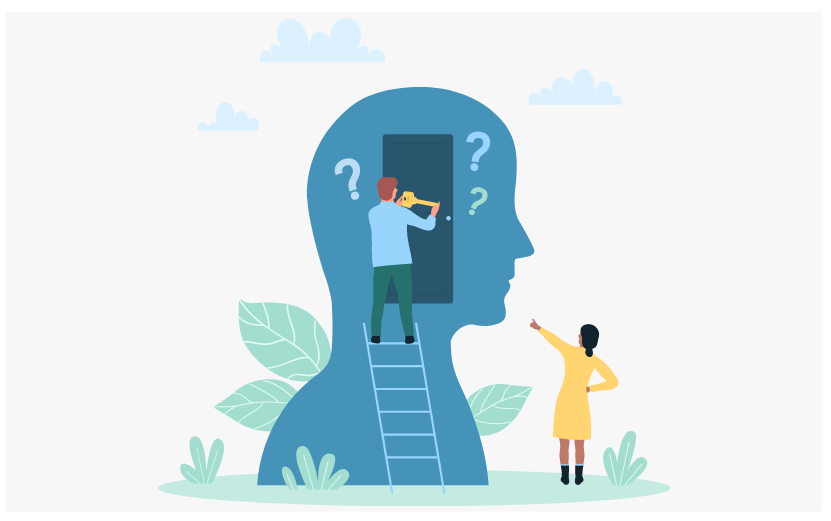» Physical and mental well-being
Distract Anxiety 14 Quick Activities
Introduction
Persistent obsessions, intrusive thoughts, and excessive rumination can exacerbate anxiety and make it difficult to focus on daily tasks. Learning how to stop thinking about something can provide relief from this mental burden.

This guide explores ten quick activities to distract your mind from unwanted thoughts, including physical exercises, mental techniques, creative outlets, and relaxation practices – effective strategies for anxiety treatment and mastering the art of refocusing your mind.
Physical Activities
Engaging in physical activities can provide an effective distraction from persistent thoughts and alleviate anxiety symptoms. Here are some recommended exercises:
1. Take a Walk or Light Exercise:
Go for a short walk, focusing on the rhythm and feel of your footsteps. Alternatively, try some light exercises or stretches, concentrating on how your body moves [2].
2. Aerobic Exercises:
- Running for at least 30 minutes can force you to focus on something other than your daily worries, helping to clear your mind and reduce stress.
- Hiking in nature offers a calm, serene setting to unwind, exercise, and release endorphins that improve mood.
- Swimming, a low-impact exercise that uses many muscles, can combat anxiety and depression symptoms while improving aerobic health.
- Dancing, even in a group setting, can be a fun aerobic exercise that can help build confidence and overcome anxiety and depression [4].
3. Structured Workouts:
- Cardio exercises like running, swimming, biking, and brisk walking can reduce anxiety symptoms by improving oxygen delivery to muscles and inducing changes in the brain that regulate the stress response [6].
- Interval training (HIIT) involving repeated bouts of high exertion followed by recovery periods has been shown to be effective in reducing anxiety symptoms [6].
- Yoga, with its focus on breathing and mindfulness, can be helpful for managing anxiety, especially when used as a complement to first-line treatments like medication and cognitive behavioral therapy [6].

Incorporating physical activities into your routine can provide a healthy outlet for releasing pent-up energy, improving mood, and distracting your mind from intrusive thoughts [1] [3] [5] [7].
Mental Exercises
Mental exercises can be powerful tools to distract your mind from intrusive thoughts and anxiety. Here are some effective techniques:
4. Cognitive Therapy Skills
- Respond to and modify thoughts to cope better and feel less anxious by gathering evidence and examining facts [8].
- Challenge negative automatic thoughts and cognitive distortions like black-and-white thinking, catastrophizing, and jumping to conclusions [8].
- Practicing these skills can rewire the brain over time to develop more realistic and helpful thought patterns [8].
5. Grounding Techniques
- Put your hands in water and focus on the temperature and sensation [2].
- Pick up objects nearby and concentrate on their texture, color, and physical properties [2].
- Breathe deeply, focusing on each inhalation and exhalation [2].
- Savor a food or drink, paying attention to the taste and flavors [2].
- Hold a piece of ice and observe how the sensation changes as it melts [2].
- Savor a pleasant scent, like a cup of tea or a scented candle [2].
- Listen to the sounds around you, noticing different noises [2].
- Tune into how your body feels from head to toe [2].
6. Mental Exercises
- Play memory games, trying to recall details of a picture [2].
- Think in categories, listing as many items as you can in a category [2].
- Use math and numbers, like counting backwards or finding different ways to make a number [2].
- Recite something you know by heart, like a poem or song [2].
- Make yourself laugh with a silly joke or funny video [2].
- Use an anchoring statement to remind yourself of your current location and situation [2].
- Visualize a daily task you enjoy, describing the steps in detail [2].
- Describe a common task you do often, like making coffee [2].
- Picture the face or voice of someone you love [2].
- Practice self-kindness with compassionate phrases [2].
- Sit with your pet and focus on how they feel [2].
- List your favorite things in different categories [2].
- Visualize your favorite place, using all your senses [2].
- Plan a future activity you’re looking forward to [2].
- Touch something comforting, like a favorite blanket [2].
- List positive things in your life that bring you joy [2].
- Listen to a favorite song, focusing on the melody and lyrics [2].
Other Techniques:
- Scribble down thoughts on random pieces of paper or in a notebook [3].
- Engage in activities that require focus, like Netflix marathons [3].
- Plan and solve problems, or think about a happy place or upcoming project [3].
- Retreat to a safe, comfortable space until you can function again [3].
- Play online puzzle games like GeoGuessr Puzzles, Jigsaw Planet, 2048 Game, or PacMan to keep the mind engaged [9].
By incorporating these mental exercises into your routine, you can effectively distract your mind from unwanted thoughts and find relief from anxiety.

Creative Outlets
Engaging in creative pursuits can provide an effective outlet for intrusive thoughts and anxiety. Here are some activities to consider
7. Writing:
Journaling, poetry, or short stories can help process emotions and channel anxious energy into creative expression [10]. Describe your thoughts, feelings, or experiences in detail to gain perspective and clarity [10].
8. Art and Crafts:
- Drawing, painting, or coloring can be soothing and meditative, allowing you to focus on the present moment [11].
- Sculpting with clay or modeling dough can be a tactile and grounding experience [11].
- Knitting, crocheting, or embroidery can be repetitive and rhythmic, promoting mindfulness [11].
- Origami, the art of paper folding, requires concentration and can be a calming activity [11].
9. Music and Dance:
Playing an instrument or singing can be an immersive and therapeutic experience, channeling emotions into creative expression [12]. Dancing, whether freestyle or following choreography, can be a physical and emotional release, promoting mindfulness and self-expression [12].
10. Photography and Videography:
Capturing moments through photography or videography can encourage you to appreciate the present and find beauty in your surroundings [13].
11. Cooking and Baking:
The process of preparing a meal or baking treats can be a sensory experience, engaging your senses and promoting mindfulness [14].
12. Gardening and Landscaping:
Tending to plants or working on a landscaping project can be a grounding and rewarding activity, allowing you to connect with nature [15].
13. DIY Projects:
Engaging in do-it-yourself projects, such as woodworking, home improvement, or crafting, can provide a sense of accomplishment and distraction from intrusive thoughts [16].
These creative outlets not only serve as distractions but also provide opportunities for self-expression, mindfulness, and personal growth, ultimately helping to alleviate anxiety and intrusive thoughts.

14. Relaxation Techniques
Relaxation techniques are therapeutic exercises designed to help individuals decrease tension and anxiety, both physically and psychologically [11]. Common techniques include:
- Box Breathing: Sit in a quiet place, place one hand on your chest and the other on your stomach, and breathe slowly and deeply through your nose, focusing on your stomach moving more than your chest [15].
- Guided Imagery: Think of an ideal, calming, peaceful, and safe place, and visualize the details of this ‘happy place’ – how it would smell, feel, and sound [15].
- Progressive Muscle Relaxation (PMR): Make a tight fist with your hand, hold for a few seconds, then slowly release. Repeat this tensing and releasing with different muscle groups in your body [15].
- Counting: Find a quiet place, close your eyes, and slowly count to 10 (or 20) [15].
- Mindfulness Meditation: Find a quiet place to sit and close your eyes. Notice your breathing and body sensations, then shift your awareness to your surroundings – what you hear, smell, and feel [15].
These techniques can help reduce physiological symptoms of stress like increased heart rate, shortness of breath, and muscle tension [11]. Relaxation has been shown to reduce cortisol levels, leading to decreased somatic and subjective experiences of stress [11]. Other effective techniques include autogenic relaxation, visualization, deep breathing, massage, meditation, tai chi, yoga, biofeedback, music/art therapy, aromatherapy, and hydrotherapy [12].
Implementing relaxation techniques regularly is important for optimal stress reduction [11]. They can provide benefits such as slowing heart rate, lowering blood pressure, improving digestion, controlling blood sugar levels, easing muscle tension and chronic pain, improving focus and mood, and enhancing sleep quality [12] [13].
Remember. It is imperative to acknowledge that while various techniques and insights may offer valuable tips, they should not be regarded as alternatives to professional therapy. Battling mental health concerns calls for intervention by a certified therapist, a pivotal move in the journey towards recovery and healing.
Conclusion
Persistent thoughts and anxiety can be overwhelming, but incorporating various activities into your routine can provide relief and distraction. Physical exercises, mental techniques, creative outlets, and relaxation practices offer effective strategies to refocus your mind and alleviate symptoms of anxiety. Remember, it’s essential to find what works best for you and consistently practice these activities to achieve long-term benefits.
Ultimately, learning how to stop thinking about something requires patience, self-compassion, and a willingness to explore different approaches. By implementing these strategies, you can gain control over intrusive thoughts, reduce anxiety, and cultivate a greater sense of peace and well-being in your daily life.

FAQs
What is the 3-3-3 rule for managing anxiety?
The 3-3-3 rule is a straightforward technique that helps you ground yourself during anxious moments. To use it, simply identify three things you can see, three sounds you can hear, and then move three different parts of your body. This method is easy to remember and can be used almost anywhere to help regain focus and calmness.
How can I redirect my thoughts when I’m anxious about something?
To shift your focus away from anxiety-inducing thoughts, you can engage in various activities. Some effective strategies include calling a friend to discuss an unrelated topic, challenging yourself to reorganize your bookshelf within ten minutes, planning your next holiday, spending time decluttering a specific area, or putting on music and dancing.
What techniques can I use to distract myself from anxious thoughts?
Alleviating anxious thoughts can be achieved through relaxation techniques such as taking slow, deep breaths and counting to ten. Other helpful practices include yoga, meditation, and various breathing exercises. Often, employing a combination of these methods can be especially effective in managing anxiety.
Can you explain the 54321 technique for anxiety relief?
The 54321 grounding exercise is designed to combat acute stress and anxiety. It involves taking note of five things you can see, four items you can physically feel, three sounds you can hear, two scents you can smell, and one taste. This sensory awareness exercise helps in bringing your attention to the present moment and reducing anxiety levels.
References
[1] – https://www.healthline.com/health/mental-health/how-to-cope-with-anxiety
[2] – https://www.healthline.com/health/grounding-techniques
[3] – https://ibpf.org/articles/18-ways-to-distract-from-anxiety/
[4] – https://talkingcirclestherapy.com/7-best-exercises-for-anxiety-and-depression/
[5] – https://adaa.org/living-with-anxiety/managing-anxiety/exercise-stress-and-anxiety
[6] – https://www.health.com/condition/depression/these-are-the-best-exercises-for-anxiety-and-depression
[7] – https://health.usnews.com/health-care/patient-advice/articles/best-exercises-to-ease-stress-and-anxiety
[8] – https://medicine.umich.edu/sites/default/files/content/downloads/Cognitive-Skills-for-Anxiety.pdf
[9] – https://www.mind.org.uk/need-urgent-help/how-can-i-distract-myself/games-and-puzzles/
[10] – https://www.helpguide.org/articles/anxiety/how-to-stop-worrying.htm
[11] – https://www.ncbi.nlm.nih.gov/books/NBK513238/
[12] – https://www.mayoclinic.org/healthy-lifestyle/stress-management/in-depth/relaxation-technique/art-20045368
[13] – https://www.helpguide.org/articles/stress/relaxation-techniques-for-stress-relief.htm
[14] – https://www.health.harvard.edu/mind-and-mood/six-relaxation-techniques-to-reduce-stress
[15] – https://www.healthline.com/health/anxiety-exercises

